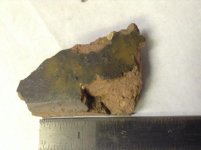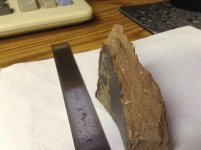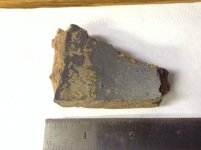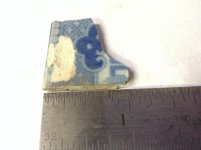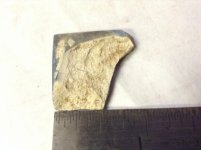You are using an out of date browser. It may not display this or other websites correctly.
You should upgrade or use an alternative browser.
You should upgrade or use an alternative browser.
How old is this pottery ?
- Thread starter MattLock
- Start date
Bayoutalker
Elite Member
It almost looks like old terra cotta sewer pipe.
Cliff
Cliff
It almost looks like old terra cotta sewer pipe.
Cliff
No way I've found two of those decting and that is not a sewer pipe piece
Bayoutalker
Elite Member
How many pieces did you find? If you had a few more pieces to put together it might help. It just looks awfully thick for pottery.
Cliff
Cliff
How many pieces did you find? If you had a few more pieces to put together it might help. It just looks awfully thick for pottery.
Cliff
Could it be a curcible ?
Bayoutalker
Elite Member
Given the curve it would be pretty large diameter. If you could figure the size that might give you a clue.
Cliff
Cliff
Given the curve it would be pretty large diameter. If you could figure the size that might give you a clue.
Cliff
It. Would only make sense that it is one
Bayoutalker
Elite Member
I can't tell from the pics, is it curved in one direction like a tube or two like a bowl?
Cliff
Cliff
It does have a cruve to itI can't tell from the pics, is it curved in one direction like a tube or two like a bowl?
Cliff
Bayoutalker
Elite Member
I can see it's curved in one direction but what about the other? A bowl would curve around the diameter and top to bottom as well like a half of a sphere.
Cliff
Cliff
BlueDog
Elite Member
I'll add my 2¢, I'm not an expert, but I do have years of experience with clay bodies, kilns, firing, glaze formulations. I'm edumicated!
It looks from the pics to be a very coarse clay body that's unvitrified. This could be from under firing, or unrefined clay. The rural kilns of the 1800's were notoriously uneven firing, and far from a science. A groundhog kiln is almost a hole in a bank, not a whole lot more.
Potters of the day didn't go get clay from a supplier, but instead located a good clay deposit that fired well and located their pottery close by. Dug clay is far from the refined clay we have today. Bits of rock, sand, and small pebbles was the norm. I'd say (educated guess) that this is fairly old.
As for the thickness. In today's world we strive for thinness of our pots, but this was seen as poorly thrown back in the day. Thick meant durable. Poor clay is almost impossible to throw thinly. Remember, potters were NOT artists. Pottery was NOT art, it was the styrofoam of the 1800's. Use it, toss it. Pots were tools. Potters got paid by the amount they made, not by the amount of clay they saved by throwing thin.
This shard could be from almost anything. A churn, a jug, a bowl, a chicken waterer or even a sewer pipe.. Anything!
This concludes my "nerd out" moment.
It looks from the pics to be a very coarse clay body that's unvitrified. This could be from under firing, or unrefined clay. The rural kilns of the 1800's were notoriously uneven firing, and far from a science. A groundhog kiln is almost a hole in a bank, not a whole lot more.
Potters of the day didn't go get clay from a supplier, but instead located a good clay deposit that fired well and located their pottery close by. Dug clay is far from the refined clay we have today. Bits of rock, sand, and small pebbles was the norm. I'd say (educated guess) that this is fairly old.
As for the thickness. In today's world we strive for thinness of our pots, but this was seen as poorly thrown back in the day. Thick meant durable. Poor clay is almost impossible to throw thinly. Remember, potters were NOT artists. Pottery was NOT art, it was the styrofoam of the 1800's. Use it, toss it. Pots were tools. Potters got paid by the amount they made, not by the amount of clay they saved by throwing thin.
This shard could be from almost anything. A churn, a jug, a bowl, a chicken waterer or even a sewer pipe.. Anything!
This concludes my "nerd out" moment.
I'll add my 2¢, I'm not an expert, but I do have years of experience with clay bodies, kilns, firing, glaze formulations. I'm edumicated!
It looks from the pics to be a very coarse clay body that's unvitrified. This could be from under firing, or unrefined clay. The rural kilns of the 1800's were notoriously uneven firing, and far from a science. A groundhog kiln is almost a hole in a bank, not a whole lot more.
Potters of the day didn't go get clay from a supplier, but instead located a good clay deposit that fired well and located their pottery close by. Dug clay is far from the refined clay we have today. Bits of rock, sand, and small pebbles was the norm. I'd say (educated guess) that this is fairly old.
As for the thickness. In today's world we strive for thinness of our pots, but this was seen as poorly thrown back in the day. Thick meant durable. Poor clay is almost impossible to throw thinly. Remember, potters were NOT artists. Pottery was NOT art, it was the styrofoam of the 1800's. Use it, toss it. Pots were tools. Potters got paid by the amount they made, not by the amount of clay they saved by throwing thin.
This shard could be from almost anything. A churn, a jug, a bowl, a chicken waterer... Anything!
This concludes my "nerd out" moment.
No thnak you are just the kind of person am looking for !
If I post more pottery can I count on you to help
BlueDog
Elite Member
No thnak you are just the kind of person am looking for !
If I post more pottery can I count on you to help
Thanks Mattlock, I will try to help if I can. But without having it in hand, it's hard to tell. I didn't mean to type so much, but I teach ceramics at a local college, and very rarely do my hobbies/obsessions cross paths.
Thanks Mattlock, I will try to help if I can. But without having it in hand, it's hard to tell. I didn't mean to type so much, but I teach ceramics at a local college, and very rarely do my hobbies/obsessions cross paths.
I found this a long time ago same area of the other thing


